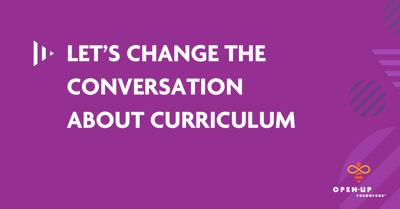 Last week, I joined leaders from one hundred of the most pioneering districts in the country at the Digital Promise League of Innovative Schools convening, always a fantastic event. These districts have a reputation for innovation with ed tech, but I’ve come to know them as innovators in many other arenas, from parent engagement to professional learning.
Last week, I joined leaders from one hundred of the most pioneering districts in the country at the Digital Promise League of Innovative Schools convening, always a fantastic event. These districts have a reputation for innovation with ed tech, but I’ve come to know them as innovators in many other arenas, from parent engagement to professional learning.
They embrace innovative instruction, for sure. Members promote student engagement and active learning in workstreams around makerspaces, real-world learning, and project-based learning.
Now, I see purposefully-developed curriculum as the most effective catalyst for engagement and hands-on learning across a school system. Yet I’ve come to realize that not all districts see the world that way.
As the League of Innovative Schools convening closed, I had a conversation that captured the issue perfectly:
G, a curriculum director, sat down next to me for lunch. I’d been discussing curriculum with another district leader.
Some of the first words out of G’s mouth: “I hate big-boxed curriculum.”
“Oh yeah? Tell me more,” I said.
“Well, they all seem to just move kids through skills,” said G. She went on to list the common complaints about traditional curriculum: not engaging enough, low-quality texts in ELA, the need to supplement the heck out of most of them, and more. G’s district had been developing its own curriculum with aligned PD, because they truly valued the role of instructional materials in teacher success, and they didn’t believe the curriculum market had anything to offer them that was as good as what they could build themselves.
I started telling her a bit about the Open Up Resources curricula—how both of our K–5 ELA curricula are designed around whole texts, so kids are reading awesome, engaging books:
https://twitter.com/karenvaites/status/1050440148524064768
I talked about EL Education K–5 Language Arts, and the way its activities and instructional routines foster significant engagement and loads of student discourse:
https://twitter.com/MrsMegertZES/status/1044618603558051840
Kids do meaningful tasks, and grapple with real-world problems, as part of the curriculum – here, authoring plans to build a Magnificent Thing after reading the text The Most Magnificent Thing:
https://twitter.com/firstgradeyap/status/1049379625124679680
The curriculum is designed around text sets with science and social studies themes, both to build content knowledge about the world and because those topics are super-engaging.
https://twitter.com/2ndGradewithMsG/status/953299152947081222
Of course, good curriculum must also excel at foundational literacy skill development, and help kids grow as readers and writers. In fact, I’d just visited Juab School District, where the superintendent described awesome gains in the first year with the curriculum:
https://twitter.com/karenvaites/status/1050794745532796928
G seemed intrigued. I turned to talking about our math curriculum, saying, “Open Up Resources 6–8 Math was developed by Illustrative Mathematics, which was founded by standards author Bill McCallum. If you’ve been developing your own materials, you must be using practice items and tasks from Illustrative Mathematics?”
“We LOVE Illustrative Math!,” said G.
I explained how the curriculum is problem-based, and designed around 2-4 activities per lesson, many of which are done collaboratively, in pairs or groups.
https://twitter.com/JuliaGillilan/status/1047175239489208320
I described my favorite lessons with real-world problems, like the fractions lesson in which kids mix colored water in different ratios, a beautiful way to foster conceptual understanding:
https://twitter.com/MrsReadout/status/1048628364943282177
… and the lesson in which they mix powdered drinks in different ratios:
https://twitter.com/JessicaBorah/status/966503446546300928
The curriculum is designed around the Five Practices, and especially the imperative to get kids talking about the math! (Just listen to this video.)
https://twitter.com/Str8Jonesy/status/942585638167171073
Students push each others’ mathematical thinking, and the teacher serves as a facilitator of math learning:
https://twitter.com/teachbmax/status/1050431349511749632
Now G was excited. “We need to talk about this! I want to look at these materials!”
Her really game-changing comment: “I wouldn’t develop materials myself if there was something excellent out there.”
Her ‘Aha’ moment: someone had developed the kinds of materials she was building herself… and was giving them away for free!
My big takeaway from this conversation with G, and similar ones with districts around the country: many educators were underwhelmed by the curriculum options available a few years ago, and they’ve stopped looking to curriculum providers for materials that promote active learning. Really, it makes sense. Why would you go looking for curriculum that scaffolds active learning today if it wasn’t available to you before?
(Also, many educators are still discovering nonprofit curriculum reviewer EdReports – G hadn’t heard of it – so they don’t know that excellence is now easy to find.)
Today’s new breed of curriculum is not ‘just content.’ These excellent curricula are instructional catalysts that actively promote the 4 C’s and deeper learning, while also supporting superb literacy and math instruction.
These are stories we need to be sharing to ensure that today’s curriculum landscape is properly understood.
Karen Vaites is the Chief Strategy Officer at Open Up Resources.
To hear additional stories about active learning through curriculum, please join our conversation with district leaders, How to Boost Active Learning in Your Schools, on November 14th and 19th.

